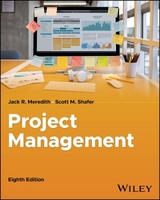
Project Management in Practice
John Wiley & Sons Inc (Verlag)
978-1-119-70296-2 (ISBN)
- Lieferbar
- Versandkostenfrei
- Auch auf Rechnung
- Artikel merken
Providing new and updated content throughout, the seventh edition’s concise pedagogy and hands-on focus is ideally suited for use in one-semester courses or modules on project management. Clear and precise chapters describe fundamental project management concepts while addressing the skills real-world project managers must possess to meet the strategic goals of their organizations. Integrated throughout the text are comprehensive cases that build upon the material from previous chapters—complemented by wealth of illustrative examples, tables and figures, review questions, and discussion topics designed to reinforce key information.
Preface xii
1 The World of Project Management 1
1.1 What is a Project? 1
1.1.1 Trends in Project Management 2
1.2 Project Management Versus General Management 4
1.2.1 Major Differences 4
1.2.2 Negotiation 5
1.3 Agile Project Management 6
1.4 What is Managed? The Three Goals of a Project 10
1.5 The Life Cycles of Projects 12
1.6 Selecting Projects to Meet Organizational Objectives 14
1.6.1 Nonnumeric Selection Methods 15
1.6.2 Numeric Selection Methods 16
1.7 The Project Portfolio Process 23
1.8 The Materials in this Text 27
Review Questions 28
Discussion Questions 29
Exercises 29
Incident for Discussion 30
Case: Friendly Assisted Living Facility—1 31
Case: Handstar Inc. 32
Bibliography 34
2 The Manager the Organization and the Team 35
2.1 The PM’s Roles 36
2.1.1 Facilitator 36
2.1.2 Communicator 38
2.1.3 Virtual Project Manager 41
2.1.4 Meetings, Convener, and Chair 42
2.2 The PM’s Responsibilities to the Project 42
2.2.1 Acquiring Resources 42
2.2.2 Fighting Fires and Obstacles 43
2.2.3 Leadership 43
2.2.4 Negotiation, Conflict Resolution, and Persuasion 45
2.3 Selection of a Project Manager 47
2.3.1 Credibility 47
2.3.2 Sensitivity 48
2.3.3 Leadership Style Ethics 48
2.3.4 Ability to Handle Stress 49
2.4 Project Management
as a Profession 50
2.5 Fitting Projects into the Parent Organization 52
2.5.1 Pure Project Organization 52
2.5.2 Functional Project Organization 53
2.5.3 Matrix Project Organization 54
2.5.4 Mixed Organizational Systems 56
2.5.5 The Project Management Office and Project Maturity 57
2.6 The Project Team 58
2.6.1 Matrix Team Problems 60
2.6.2 Intrateam Conflict 60
2.6.3 Integration Management 63
2.7 Agile Team Roles 65
Review Questions 67
Discussion Questions 68
Incidents for Discussion 69
Case: Friendly Assisted Living Facility—2 70
Case: The Quantum Bank 70
Case: Southern Care Hospital 71
Bibliography 73
3 Project Activity and Risk Planning 75
3.1 From the Project Charter to the Project Plan 75
3.2 The Planning Process—Overview 77
3.3 The Planning Process—Nuts and Bolts 78
3.3.1 The Launch Meeting—and Subsequent Meetings 78
3.3.2 Sorting Out the Project—The Work Breakdown Structure (WBS) 80
3.3.3 Extensions of the Everyday WBS 83
3.4 More on the Work Breakdown Structure and Other Aids 86
3.4.1 The RACI Matrix 87
3.4.2 A Whole-Brain Approach to Project Planning 88
3.4.3 The Design Structure Matrix 91
3.5 Project Planning with Scrum 92
3.5.1 Scrum Artifacts Supporting Project Planning 93
3.5.2 Scrum Events for Project Planning 94
3.5.3 Risk Management with Scrum 96
3.6 Risk Management 96
Review Questions 103
Discussion Questions 103
Exercises 104
Incidents for Discussion 106
Case: Friendly Assisted Living Facility—3 107
Case: John Wiley & Sons 108
Case: Samson University 108
Bibliography 109
4 Budgeting the Project 111
4.1 Methods of Budgeting 112
4.1.1 Top-Down Budgeting 114
4.1.2 Bottom-Up Budgeting 114
4.1.3 Budgeting With Agile 115
4.2 Cost Estimating 115
4.2.1 Work Element Costing 115
4.2.2 The Impact of Budget Cuts 116
4.2.3 An Aside 118
4.2.4 Activity Versus Program Budgeting 119
4.3 Improving Cost Estimates 121
4.3.1 Forms 121
4.3.2 Learning Curves 122
4.3.3 Other Factors 124
4.4 Budget Uncertainty and Project Risk Management 126
4.4.1 Budget Uncertainty 126
4.4.2 Project Budgeting in Practice 129
4.5 Project Risk Simulation with Crystal Ball®130
4.5.1 Considering Disaster 137
Review Questions 137
Discussion Questions 137
Exercises 138
Incidents for Discussion 140
Case: Friendly Assisted Living Facility Project
Budget Development—4 141
Case: Photstat Inc. 143
Case: Building the Geddy’s dream house 143
Bibliography 144
5 Scheduling the Project 145
5.1 PERT and CPM Networks 145
5.1.1 The Language of PERT/CPM 146
5.1.2 Building the Network 146
5.1.3 Finding the Critical Path and Critical Time 148
5.1.4 Calculating Activity Slack 151
5.1.5 Doing It the Easy Way—Microsoft Project (MSP) 152
5.2 Project Uncertainty and Risk Management 154
5.2.1 Calculating Probabilistic Activity Times 154
5.2.2 The Probabilistic Network, An Example 155
5.2.3 Once More the Easy Way 157
5.2.4 The Probability of Completing the Project on Time 158
5.2.5 Selecting Risk and Finding D 161
5.2.6 The Case of the Unreasonable Boss 161
5.2.7 A Potential Problem: Path Mergers 162
5.3 Simulation 163
5.3.1 Incorporating Costs into the Simulation Analysis 165
5.3.2 Traditional Statistics Versus Simulation 166
5.3.3 Some Common Issues 168
5.3.4 Simulation 168
5.4 The Gantt Chart 169
5.4.1 The Chart 169
5.5 Extensions to PERT/CPM 171
5.5.1 Precedence Diagramming 171
5.5.2 Final Thoughts on the Use of These Tools 172
5.6 Scheduling with Scrum 174
Review Questions 176
Discussion Questions 177
Exercises 177
Discussion Exercise 181
Incidents for Discussion 182
Case: Friendly Assisted Living Facility Program Plan—5 183
Case: NutriStar 186
Case: Launching E-Collar 187
Bibliography 188
6 Allocating Resources to the Project 189
6.1 Expediting a Project 190
6.1.1 The Critical Path Method 190
6.1.2 Crashing a Project With Excel 194
6.1.3 Fast-Tracking a Project 197
6.1.4 Project Expediting in Practice 197
6.2 Resource Loading 199
6.2.1 The Charismatic VP 204
6.3 Resource Leveling 204
6.3.1 Resource Loading/Leveling and Uncertainty 211
6.4 Allocating Scarce Resources to Projects 212
6.4.1 Some Comments About Constrained Resources 213
6.4.2 Some Priority Rules 213
6.5 Allocating Scarce Resources to Several Projects 214
6.5.1 Criteria of Priority Rules 216
6.5.2 The Basic Approach 216
6.5.3 Resource Allocation and the Project Life Cycle 217
6.6 Goldratt’s Critical Chain 218
6.6.1 Estimating Task Times 220
6.6.2 The Effect of Not Reporting Early Activity Completion 221
6.6.3 Multitasking 223
6.6.4 Common Chain of Events 224
6.6.5 The Critical Chain 225
Review Questions 226
Discussion Questions 227
Exercises 227
Incidents for Discussion 231
Case: Friendly Assisted Living Facility Resource Usage—6 232
Case: Charter Financial Bank 233
Case: Rand Contractors 234
Bibliography 235
7 Monitoring and Controlling the Project 236
7.1 The Plan–Monitor–Control Cycle 236
7.1.1 Designing the Monitoring System 237
7.2 Data Collection and Reporting 238
7.2.1 Data Analysis 239
7.2.2 Reporting and Report Types 239
7.2.3 Meetings 241
7.2.4 Virtual Meetings, Reports, and Project Management 242
7.3 Earned Value 243
7.4 Project Control 250
7.4.1 Purposes of Control 250
7.5 Designing the Control System 252
7.5.1 Types of Control Systems 253
7.5.2 Tools for Control 254
7.6 Scope Creep and Change Control 257
7.7 Agile Approaches for Project Monitoring and Control 259
7.7.1 Agile Tools for Tracking Project Progress 259
7.7.2 Scrum Events for Project Control 261
Review Questions 262
Discussion Questions 262
Exercises 263
Incidents for Discussion 265
Case: Friendly Assisted Living Facility Updates—7 266
Case: Palmstar Enterprises, Inc. 269
Case: Peak Lighting, Inc. 269
Bibliography 270
8 Evaluating and Closing the Project 272
8.1 Evaluation 272
8.1.1 Evaluation Criteria 273
8.1.2 Measurement 273
8.2 Project Auditing 274
8.2.1 The Audit Process 275
8.2.2 The Audit Report 276
8.3 Project Closure 279
8.3.1 When to Close a Project 280
8.3.2 Types of Project Closure 281
8.3.3 The Closure Process 282
8.3.4 The Project Plan Closeout Report 283
8.4 Benefits Realization 285
Review Questions 286
Discussion Questions 287
Incidents for Discussion 287
Case: Friendly Assisted Living Facility Audit—8 288
Case: Datatech 291
Case: Ivory Tower Systems 292
Bibliography 293
Appendix A-1
Index I-1
| Erscheinungsdatum | 23.10.2020 |
|---|---|
| Verlagsort | New York |
| Sprache | englisch |
| Maße | 201 x 252 mm |
| Gewicht | 567 g |
| Themenwelt | Wirtschaft ► Betriebswirtschaft / Management ► Projektmanagement |
| ISBN-10 | 1-119-70296-8 / 1119702968 |
| ISBN-13 | 978-1-119-70296-2 / 9781119702962 |
| Zustand | Neuware |
| Informationen gemäß Produktsicherheitsverordnung (GPSR) | |
| Haben Sie eine Frage zum Produkt? |
aus dem Bereich



